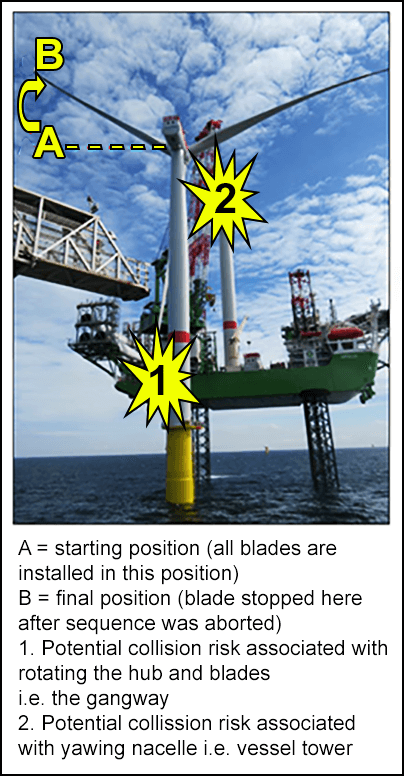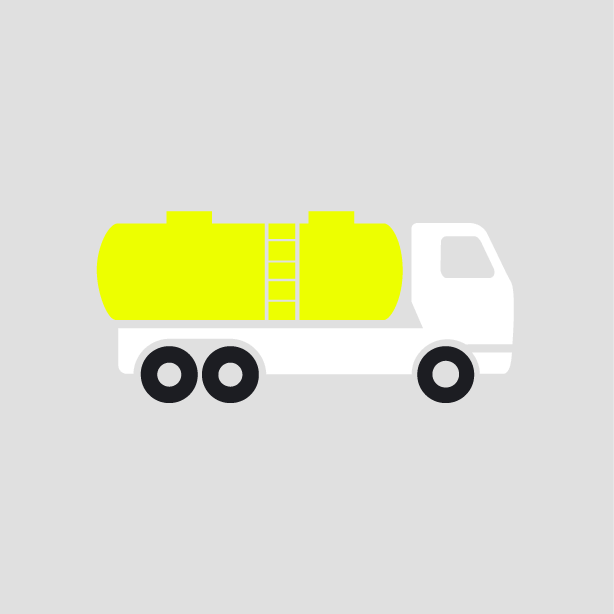-
What happened?
Technicians were installing blades on a wind turbine generator (WTG).
After completing the installation, the hub rotated and struck the gangway between the installation vessel and transition piece.
The impact of the blade knocked the gangway into the sea.
All technicians were working inside the WTG at the time of incident, so no one was injured, but they remained stranded at the location.

-
Why did it happen?
Turning sequence was aborted by tower foreman after the 4-hole position, which resulted in the blade striking the gangway. This increases the risk of someone unintentionally rotating the blades into other objects in the surrounding area.
Gangway was in the rotor plane of the blade due to the height of the installation vessel.
Clearance options were limited due to the size of the WTG and vessel.
Collision risk was considered and discussed by the team, but the gangway wasn’t removed.
The safe system of work (SSoW) and procedure did not make reference to the hazards of blade collision, or provide instruction on how far the hub should be rotated. The work methodology used was therefore inconsistent for each WTG, with inconsistent results.
Hazards were not considered or fully addressed during the toolbox talk.
‘Take 5’ risk assessment (stop, look, assess, control and monitor) was not completed. This should have identified requirements for spotters and raised questions about the instructions received during the toolbox talk.

-
What did they learn?
Rotating the hub so blades are in ‘bunny ear’ position removes the risk of colliding with the tower on the installation vessel during yawing.
SSoW should clearly state how far the hub should be rotated, i.e. bolt hole rotation, to avoid collisions whilst the blades turn and during the yawing of the nacelle.
Risk assessment should address the hazard of blades striking the gangway during rotation.
Establish spotters and ensure good communication methods with other key roles are in place.
Conduct a walkthrough of the task using the available documentation before the activity is due to take place.
All supervisors should be briefed on work procedures. Instructions on safety critical tasks should be captured in pre-task plans, work instructions and risks assessments, and NOT in toolbox talk documents.
When planning the job, consider significant risks associated with equipment selection– e.g. vessel size. Ensure risks associated with the vessel and simultaneous operations can be managed.

-
Ask yourself or your crew
How can something like this happen here?
How do you know how far can the hub be safely rotated (without striking the gangway/tower/vessel)?
How can you check all collision risks have been addressed and mitigated in the risk assessments?
What is our emergency response procedure if we were to remain stranded inside the turbine?
What measures do we have in place for preventing this from happening here? How can we improve?

Add to homescreen
Content name
Select existing category:
Content name
New collection
Edit collection
What happened?
Technicians were installing blades on a wind turbine generator (WTG).
After completing the installation, the hub rotated and struck the gangway between the installation vessel and transition piece.
The impact of the blade knocked the gangway into the sea.
All technicians were working inside the WTG at the time of incident, so no one was injured, but they remained stranded at the location.
Why did it happen?
Turning sequence was aborted by tower foreman after the 4-hole position, which resulted in the blade striking the gangway. This increases the risk of someone unintentionally rotating the blades into other objects in the surrounding area.
Gangway was in the rotor plane of the blade due to the height of the installation vessel.
Clearance options were limited due to the size of the WTG and vessel.
Collision risk was considered and discussed by the team, but the gangway wasn’t removed.
The safe system of work (SSoW) and procedure did not make reference to the hazards of blade collision, or provide instruction on how far the hub should be rotated. The work methodology used was therefore inconsistent for each WTG, with inconsistent results.
Hazards were not considered or fully addressed during the toolbox talk.
‘Take 5’ risk assessment (stop, look, assess, control and monitor) was not completed. This should have identified requirements for spotters and raised questions about the instructions received during the toolbox talk.

What did they learn?
Rotating the hub so blades are in ‘bunny ear’ position removes the risk of colliding with the tower on the installation vessel during yawing.
SSoW should clearly state how far the hub should be rotated, i.e. bolt hole rotation, to avoid collisions whilst the blades turn and during the yawing of the nacelle.
Risk assessment should address the hazard of blades striking the gangway during rotation.
Establish spotters and ensure good communication methods with other key roles are in place.
Conduct a walkthrough of the task using the available documentation before the activity is due to take place.
All supervisors should be briefed on work procedures. Instructions on safety critical tasks should be captured in pre-task plans, work instructions and risks assessments, and NOT in toolbox talk documents.
When planning the job, consider significant risks associated with equipment selection– e.g. vessel size. Ensure risks associated with the vessel and simultaneous operations can be managed.
Ask yourself or your crew
How can something like this happen here?
How do you know how far can the hub be safely rotated (without striking the gangway/tower/vessel)?
How can you check all collision risks have been addressed and mitigated in the risk assessments?
What is our emergency response procedure if we were to remain stranded inside the turbine?
What measures do we have in place for preventing this from happening here? How can we improve?
Technicians were installing blades on a wind generator turbine (WTG). After completing the installation, the hub rotated and struck the gangway between the installation vessel and transition piece.













